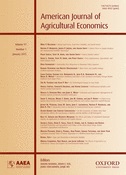Last updated on December 15, 2014
When they are high, not when they are volatile. That is, increases in the mean of the world food price distribution appear to cause increases in social unrest, whereas increases in the variance of the world food price distribution seem to have no impact on social unrest. At best, food price volatility is associated with decreases in social unrest.
Those are the core findings in my most recent published article titled “Rising Food Prices, Food Price Volatility, and Social Unrest.” The article is published in the January 2015 issue of the American Journal of Agricultural Economics. Here is the abstract:
Can food prices cause social unrest? Throughout history, riots have frequently broken out, ostensibly as a consequence of high food prices. Using monthly data at the international level, this article studies the impact of food prices – food price levels as well as food price volatility – on social unrest. Because food prices and social unrest are jointly determined, data on natural disasters are used to identify the causal relationship flowing from food price levels to social unrest. Results indicate that for the period 1990–2011, food price increases have led to increases in social unrest, whereas food price volatility has not been associated with increases in social unrest. These results are robust to alternative definitions of social unrest, to using real or nominal prices, to using commodity-specific price indices instead of aggregated price indices, to alternative definitions of the instrumental variable, to alternative definitions of volatility, and to controlling for non-food-related social unrest.
